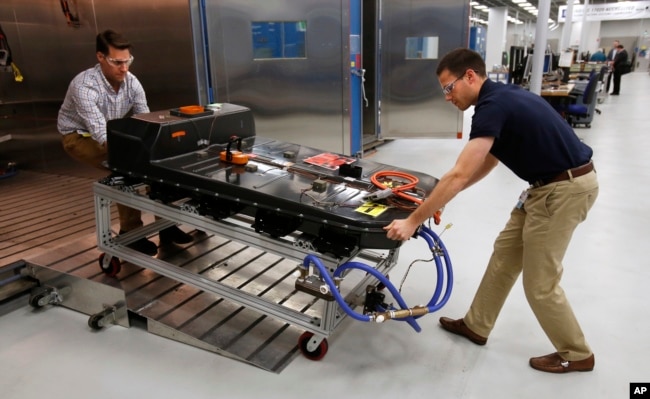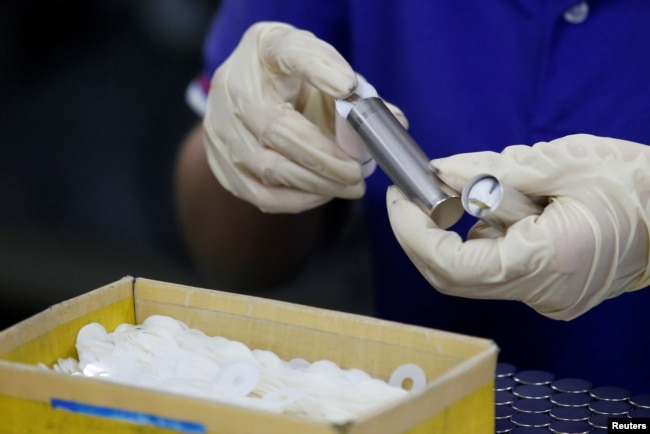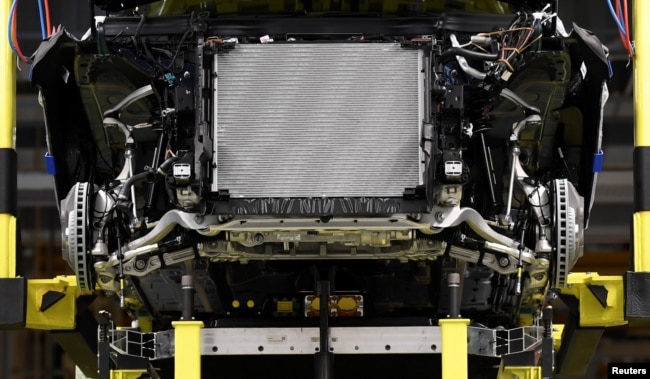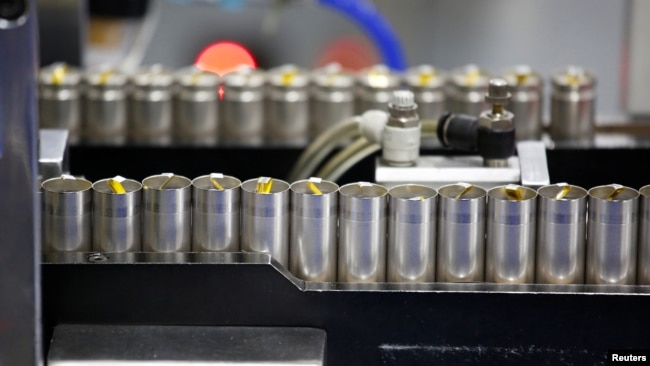聴いても、すんなり入ってきません。単語不足です!!
VOAで英語を学びましょう!!
電気自動車用電池の技術を探る(和訳)
Exploring the Technology Behind Electric Vehicle Batteries
3 hours ago
編集部注:この記事は、電気自動車技術をめぐる主要な問題を探る3部構成の第1部です。
私たちが毎日使っている電子機器の電源としているので、電池は私たちの生活に欠かせない存在になっています。
電池の主な目的は、電気を供給し、貯蔵することです。そのため、より小型で高性能の電池を開発することが求められてきました。そして、より長い時間電気を蓄えることができるデバイスを作りたいと考えています。
今後、最も大きなニーズが見込まれるのは、電気自動車(EV)市場です。ガソリン車から電気自動車への移行は、政府の施策の一環でもあります。ガソリン車から電気自動車への移行は、政府の施策の一つであり、二酸化炭素をはじめとする熱排出量の削減が求められています。
現在、最も多く使われている電池はリチウムイオン電池です。スマートフォンからパソコン、EVまで、あらゆる機器の電源として使われています。リチウムイオン電池は、今後もEVに最も多く使用されることが予想されます。
電池の主要部品は正極と負極の2つであると、米国エネルギー省のアルゴンヌ国立研究所は説明しています。正極は電池のプラス側、負極はマイナス側として機能します。
正極と負極の間には、電解液と呼ばれる化学溶液があり、電荷の流れができるようになっています。イオンと呼ばれるプラスに帯電したリチウムの粒子が電解液中を移動し、負極から正極に移動します。この動きによって、電子の連続的な流れが生じ、電気が供給されます。
リチウムイオン二次電池が充電されると、化学反応は逆に起こります。つまり、リチウムイオンは正極から負極に戻るのです。
リチウムイオン電池の主な材料は、軽金属であるリチウムです。その他に必要な材料として、炭素の一種であるグラファイトや、金属のコバルト、マンガン、ニッケルがあります。
リチウムイオン電池の正極は、一般的にコバルト、マンガン、ニッケルでできています。負極はグラファイトでできていて、正極も負極もリチウムを蓄えることができます。
正極に含まれるニッケルは、高いエネルギー密度を生み出します。正極に含まれるニッケルはエネルギー密度が高く、1回の充電でより遠くまで走ることができます。コバルトは、正極の過熱や発火を防ぎます。また、自動車メーカーが通常8〜10年保証しているEV用電池の寿命を延ばすことができます。
これらの材料は現在、リチウムイオン電池の製造に広く使用されています。しかし、需要の増加により価格が上昇し、メーカーには供給上の問題が生じています。そこで、多くの企業が使用する化学物質の組み合わせを変更する方法を研究しています。
アルゴンヌ国立研究所の研究者たちは、マンガンとリチウムの使用量を増やし、コバルトの量を減らす方法を開発しています。この方法はコストを削減し、元素をより多く利用することができます。マンガンを使った実験では、電池のエネルギー密度と安全性を向上させることもできると研究者たちは述べています。
「エネルギー貯蔵に対する需要は、一つの技術で満たすには大きすぎる...」と研究者のジェイソン・クロイ氏はプレスリリースで述べています。彼はアルゴンヌの化学科学・工学部門の物理学者です。「マンガンはそのための良い選択肢です。」とクロイ氏は付け加えました。
自動車メーカーの中には、自動車の動力源として別の種類の電池、つまり固体電池に注目しているところもあります。
リチウムイオンと固体電池の主な違いは、固体電池には液体の電解質が含まれていないことであります。その代わり、薄い固体電解質の層が正極と負極の間でリチウムイオンを運びます。
EV用固体電池の開発は、現在も継続しています。ロイター通信の取材に応じた業界専門家は、これらの電池の大量生産は少なくとも3~5年先だと述べています。
固体電池に投資しているメーカーは、この技術によってよりエネルギー密度の高い電池が得られると述べています。つまり、より小型化したり、より長い距離を走るためのパワーを保持したりすることができるのです。また、ソリッドステート・バッテリー(固体電池バッテリー)は充電速度が速く、発火の危険性も低くなります。
しかし同時に、固体電池から電力を引き出すのは難しいのです。また、リチウムイオン電池に比べて寿命が短くなる可能性もあります。業界の専門家によると、コストも大きな考慮事項です。現在、固体電池はリチウムイオン電池の約8倍の製造コストがかかっているのです。
今のところ、固体電池に多額の投資をしている自動車メーカーは、フォード、BMW、トヨタ、フォルクスワーゲン、ヒュンダイなどです。彼らは現在、いつかリチウムイオンと効果的に競争できるEV製品を作ることを期待して、この技術を改善しようとしているのです。
Exploring the Technology Behind Electric Vehicle Batteries
Editor’s note: This story is the first in a three-part series that will explore the main issues surrounding electric vehicle technologies.
Because they power electronic devices we depend on every day, batteries have become an important part of our lives.
The main purpose of a battery is to provide and store electricity. Companies have long sought to develop smaller, more powerful batteries. They want to make devices that can hold an electrical charge for longer periods of time.
One of the biggest future needs for batteries is expected to be the electric vehicle, or EV, market. The change from cars powered by gasoline to electric vehicles is partly the result of government measures. Governments say they want to reduce levels of carbon dioxide and other heat-trapping emissions.
The most common kind of battery in use today is the lithium-ion battery. These devices power everything from smartphones to computers and EVs. Lithium-ion batteries are expected to remain the most widely used for EVs in the future.
The two main parts of a battery are the cathode and anode, the U.S. Department of Energy’s Argonne National Laboratory explains. The cathode acts as the battery’s positive side, while the anode is the negative side.
A chemical solution called an electrolyte permits the flow of electrical charge between the cathode and anode. Positively charged particles of lithium, known as ions, move through the electrolyte traveling from the anode to the cathode. This movement creates a continuous flow of electrons to provide electricity.
When a rechargeable lithium-ion battery is charged, the chemical reactions happen in the opposite way. This means the lithium ions travel from the cathode back to the anode.
One of the main materials used to produce lithium-ion batteries is lithium, a light metal substance. Other necessary materials include graphite, a form of carbon, as well as the metals cobalt, manganese and nickel.
The cathode in a lithium-ion battery is generally made of cobalt, manganese and nickel. The anode is made of graphite. Both the cathode and anode can store lithium.
Nickel contained in the cathode creates high energy density. This permits EVs to travel farther on a single charge. Cobalt ensures that cathodes do not easily overheat or catch fire. It also helps to extend the life of EV batteries, which automakers usually guarantee for eight to 10 years.
These materials are currently widely used to produce lithium-ion batteries. But increasing demand has led to higher prices and supply problems for manufacturers. So, many companies are studying ways to change the mix of chemicals they use.
Researchers at the Argonne National Laboratory have been developing a method that increases the use of manganese and lithium, while reducing the amount of cobalt. This method reduces costs, and the element is more available. Experiments with manganese have shown it can also improve a battery’s energy density and safety, the researchers said.
“The demand for energy storage is too great for one technology to fulfill it…” researcher Jason Croy said in a press release. He is a physicist in Argonne’s Chemical Sciences and Engineering department. “Manganese is a good option for that,” Croy added.
Some automakers are looking to another kind of battery to power their cars – solid state batteries.
The main difference between lithium-ion and solid state is that solid state batteries do not contain a liquid electrolyte. Instead, thin layers of solid electrolytes carry lithium ions between the cathode and anode.
The development of solid-state batteries for EVs remains ongoing. Industry experts who spoke with Reuters news agency said mass production of these batteries is at least three to five years away.
Manufacturers investing in solid-state have said the technology provides batteries that are more energy dense. This means they can be made smaller or hold more power for longer trips. Solid-state batteries can also charge faster and are less likely to catch fire.
At the same time, it is harder to draw power from solid-state batteries. And they can have a shorter overall life than lithium-ion batteries. Industry experts say cost is also a major consideration. Currently, a solid-state battery costs about eight times more to produce than lithium-ion ones.
So far, automakers investing heavily in solid-state include Ford, BMW, Toyota, Volkswagen and Hyundai. They are currently attempting to improve the technology in hopes of creating an EV product that can one day effectively compete with lithium-ion.
Words in This Story
battery – n. a device that provides and stores electricity for electronic devices, vehicles, etc.
emission – n. the act of producing or sending out something (such as energy or gas) from a source
positive – adj. an electrical charge that is carried by protons
negative – adj. a charge that has more electrons than protons
density – n. the relationship between the weight of a substance and its size
option – n. a choice
physicist – n. a person who specializes in the field of physics



